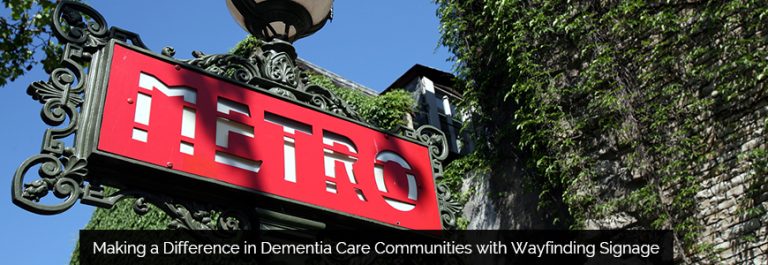Today’s post explains the Signworld business alliance’s part in making dementia care communities safer using high-quality, fully customizable wayfinding signage.
Supporting Alzheimer Sufferers with Wayfinding Signage
One of the earliest symptoms of Alzheimer’s disease is the inability to find one’s way, a problem which is only exacerbated in senior residential environments and dementia care communities with complex floor plans, nondescript hallways, and confusing or inadequate information (Davis & Ohman, 2016).
To manage this problem, the Journal of Advanced Nursing recommends the use of more “salient cues” to “help persons with Alzheimer’s find their way more effectively so they can maintain their independence” (Davis & Ohman, 2016, p. 1677).
That means more wayfinding signage in homes, which is something the Signworld business alliance is passionate about. We understand that better wayfinding for seniors means meeting the fundamental need of sleep, food, and socialization; in the words of Davis & Ohman (2016), “wayfinding can affect comfort, function, and quality of life.” Thus, in addition to being the leading producers of high-quality wayfinding signage, we’ve put together this simple guide on which wayfinding signs work best in order to help care facilities around the country meet the needs of their residents.
What Wayfinding Signs Work Best?
Davis & Ohman (2016) stress a number of factors for effective wayfinding signage:
- Visual cues must have “salience,” which means they need to be distinct enough to attract an individual’s attention (p. 1679);
- Use bright, high contrast color to enhance object recognition and recall for dementia sufferers (p. 1679);
- Include familiar cues as often as possible and avoid dramatic changes/updates to your symbol or coding system (p. 1679).
In one study published in Environment and Behavior, O’Neill (1991) compared the travel rates in spaces that had either no signage, textual signage, or graphic signage.
Overall, the addition of wayfinding signage improved the travel rate among participants by 13%. The rate at which wrong turns occurred decreased by 50%, and a 62% decrease in backtracking was recorded in all five settings (O’Neill, 1991).
But which signs performed best?
Graphic signage produced the highest rate of travel in all settings, which suggests that this type of sign is more engaging, and noticeable enough for instructions to get spotted, read, and implemented right away.
Some common examples of graphic wayfinding signage include large fingers or arrows pointing left or right, or toilet illustrations to indicate a bathroom.
Textual signage did not attract as many eyes as its graphic counterpart, but it was proven most effective in reducing wayfinding errors, such as wrong turns and backtracking (O’Neill, 1991). This was presumed to be due to the fact that graphic signage leaves more open to interpretation, both in terms of what the symbols mean and the precise direction they’re pointing. On the contrary, textual signage explicitly states instructions, leaving nothing to chance.
There were some limitations to this study. For example, the study sample was rather small. Another problem is that the complexity of the floorplans varied somewhat from setting to setting, and the researchers did not offer a solution to control for this variability in their results.
Finally, the study did not factor in how deteriorating eyesight would affect preference for textual or graphic signage. Since many residents in dementia care communities may have poor vision or reading comprehension issues as their condition worsens over time, graphic signage may indeed be a superior choice, contrary to what this study suggests.
Book an appointment with our wayfinding signage team at https://www.signworld.org
References
Davis, R., & Ohman, J. (2016). Wayfinding in ageing and Alzheimer’s disease within a virtual senior residence: study protocol. Journal of advanced nursing, 72(7), 1677-1688.
O’Neill, M. J. (1991). Effects of signage and floor plan configuration on wayfinding accuracy. Environment and Behavior, 23(5), 553-574.




